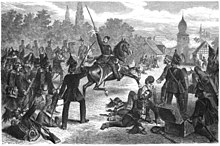| Brunswick Ducal Field-Corps | |
|---|---|
 The Brunswick Ducal Corps at the Battle of Halberstadt led by the Black Duke | |
| Active | 1809-1820s |
| Nickname(s) | Schwarze Schar (Black Troop/Horde/Host) Schwarze Legion (Black Legion) Black Brunswickers |
| Motto(s) | Sieg oder Tod! (Victory or Death!) |
| March | Marsch Herzog von Braunschweig |
| Engagements | Battle of Halberstadt Battle of Olper Battle of Quatre Bras Battle of Waterloo |

The Brunswick Ducal Field-Corps (German: Herzoglich Braunschweigisches Feldcorps), commonly known as the Black Brunswickers, was a volunteer military unit raised by Frederick William, Duke of Brunswick-Wolfenbüttel during the Napoleonic Wars. The Duke was a strong opponent of Napoleon's occupation of German territory.[1] Formed in 1809 when war broke out between the First French Empire and the Austrian Empire, the unit initially consisted of approximately 2,300 infantrymen and cavalrymen before incorporating a number of artillery troops.[1][2][3]
Most members of the unit wore distinctive black uniforms, although some soldiers, such as light infantrymen and uhlans, wore green uniforms. The Black Brunswickers also wore silver totenkopf badges on their hats. Their title originated from the Duke, who claimed Brunswick–Lüneburg, which the French had abolished in order to incorporate its lands into the Kingdom of Westphalia. The unit earned themselves a fearsome reputation over the following decade, taking part in several significant battles, including the Battle of Quatre Bras on 16 June 1815, where the Duke lost his life. However, recruiting, the replacement of casualties, and finance had always been problematic for the unit, which was disbanded in the early 1820s.
The exploits of the Black Brunswickers caught the British public's imagination during the Victorian era: an example of this can be found in John Everett Millais's painting The Black Brunswicker. Completed in 1860, the painting depicts a Brunswicker in his black uniform bidding goodbye to an unnamed woman.
- ^ a b "Osprey Publishing". Archived from the original on 27 September 2007. Retrieved 7 April 2007.
- ^ "Lady Lever Art Gallery - artwork of the month". Retrieved 7 April 2007.
- ^ "Infoplease.com". Retrieved 7 April 2007.